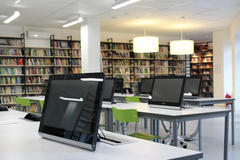vlab gives you a CSE lab desktop session on non-CSE computers, including UNSW library computers, your own laptop or desktop, and mobile phones and tablets.

Security considerations
VNC itself is based on the RFB remote-access network protocol. It is an insecure protocol. Someone with access to the raw network traffic can easily monitor what is going on including entry of your user name and password.
Inside UNSW network traffic is reasonably protected and so we allow devices on UNSW networks to connect to vlab directly. Network traffic from outside of UNSW — such as broadband traffic, connections from your home or connections from elsewhere in Australia or overseas — needs to be encrypted to make sure that evil people can't monitor your VNC connections and see what you're doing.
This is why the vlab servers will not accept direct connections from outside of UNSW. To connect to vlab from out side UNSW you need to use one of the methods explained on the connecting-to-vlab page.
Also, and as noted on the above page — but repeated here because this is the "Security considerations" section, VNC does support connection passwords but vlab does not use them because it provides a separate login screen where you enter your CSE user name and password, or zID and zPass, to gain access. You should turn off authentication in your VLC client when connecting to vlab.
Finally, it would be unwise to use vlab from an Internet cafe simply because doing anything that involves entering your username and password, even via a VPN, in an Internet cafe is risky because you don't know how well maintained and how secure the computers are there.